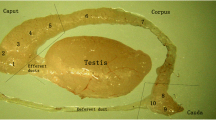Summary
Luteinizing hormone (LH) binds to the Leydig cells of several mammalian species where it stimulates steroidogenesis, protein synthesis and protein phosphorylation. In the present study, standard immunoperoxidase (PAP) and avidin-biotin complex (ABC) techniques were used to detect the binding of endogenous and exogenous LH to the epididymis of the mature mouse. Throughout the epididymal duct, a positive reaction for peroxidase, indicating LH binding, occurred in the Golgi area of principal cells. In segment 1, positive reactions were also visualized in the perinuclear area and in the region located between the Golgi area and the apical surface of the principal cells (supra-Golgi area). In the corpus and cauda epididymidis, scattered entire principal cells were also positive. Throughout the epididymal duct, the reactions indicating the binding of exogenous LH were more intense than those of endogenous LH. The significance of LH binding to the epididymis is uncertain but LH may perform the same functions in epididymal principal cells as it does in Leydig cells.
Similar content being viewed by others
References
Aafjes JH, Vreeburg JTM (1972) Distribution of 5 α-dihydrotestosterone in the epididymis of bull and boar, and its concentration in rat epididymis after ligation of efferent testicular ducts, castration, and unilateral gonadectomy. J Endocrinol 53:85–93
Abe K, Takano H, Ito T (1983) Ultrastructure of the mouse epididymal duct with special reference to the regional differences of the principal cells. Arch Histol Jpn 46:51–68
Aggarwal BB, Light P, Papkoff H, Bona-Gallo A (1980) Interaction of equine LH with binding sites for FSH in the rat seminiferous tubules. Endocrinology 107:725–731
Brooks DE (1981) Secretion of proteins and glycoproteins by the rat epididymis: regional differences, androgen-dependence, and effects of protease inhibitors, procaine and tunicamycin. Biol Reprod 25:1099–1117
Burgos MH (1964) Uptake of colloidal particles by cells of the caput epididymis. Anat Red 148:517–525
Catt KJ, Harwood JP, Clayton RN, Davies TF, Chan V, Katikineni M, Nozu K, Dufau ML (1980) Regulation of peptide hormone receptors and gonadal steroidogenesis. Recent Prog Horm Res 36:557–622
Christensen AK, Gillem SW (1969) The correlation of fine structure and function in steroid-secreting cells, with emphasis on those of the gonads. In: McKerns KW (ed) The gonads. Appleton-Century-Crofts, New York, pp 415–488
Crabo B, Gustafson B (1964) Distribution of sodium and potassium and its relation to sperm concentration in the epididymal plasma of the bull. J Reprod Fertil 7:337–346
Dravland E, Joshi MS (1981) Sperm-coating antigens secreted by the epididymis and seminal vesicle of the rat. Biol Reprod 25:649–658
Fleischer B, Fleischer S, Ozawa H (1969) Isolation and characterization of Golgi membranes from bovine liver. J Cell Biol 43:59–79
Flickenger CJ, Wilson KM, Gray HD (1984) The secretory pathway in the mouse epididymis as shown by electron microscope radioautography of principal cells exposed to monensin. Anat Rec 210:435–448
Frankel AI, Eik-Nes KB (1970) Testosterone and dehydro-epiandrosterone in the epididymis of the rabbit. J Reprod Fertil 23:441–445
Friend DS, Farquhar MC (1967) Functions of coated vesicles during protein absorption in the rat vas deferens. J Cell Biol 35:357–376
Gloyna RE, Wilson JD (1969) A comparative study of the conversion of testosterone to 17-βhydroxy-5αandrostan-3-one (dihydrotestosterone) by the prostate and the epididymis. J Clin Endocrinol Metab 29:970–977
Hamilton DW (1971) Steroid functions in the mammalian epididymis. J Reprod Fertil (Suppl) 13:89–97
Hamilton DW, Fawcett DW (1970) In vitro synthesis of cholesterol and testosterone from acetate by rat epididymis and vas deferens. Proc Soc Exp Biol Med 133:693–695
Hamilton DW, Jones AL, Fawcett DW (1969) Cholesterol biosynthesis in the mouse epididymis and ductus deferens: a biochemical and morphological study. Biol Reprod 1:167–184
Janszen FHA, Cooke BA, van der Molen HJ (1977) Specific protein synthesis in isolated rat testis Leydig cells. Influence of luteinizing hormone and cyclohexamide. Biochem J 162:341–346
Kihlstrom JE, Hall H, Lakomaa A (1975) Distribution of an adenohypophyseal constituent in the body. 1. Whole-body autoradiographical studies in the mouse. Acta Physiol Scand 93:409–414
Mancini RE, Castro A, Seiguer AC (1967) Histologic localization of follicle-stimulating and luteinizing hormones in the rat testis. J Histochem Cytochem 15:516–525
Mason KE, Shaver SL (1952) Some functions of the caput epididymis. Ann NY Acad Sci 55:585–593
Moore HDM (1980) Localization of specific glycoproteins secreted by the rabbit and hamster epididymis. Biol Reprod 22:705–718
Nicander L (1965) An electron microscopical study of absorbing cells in the posterior caput epididymis of rabbits. Z Zellforsch 66:829–847
O'Shaughnessy PJ, Payne AH (1982) Differential effects of single and repeated administration of gonadotropins on testosterone production and steroidogenic enzymes in Leydig cell populations. J Biol Chem 257:11503–11509
Prakash A, Moore HDM (1982) Localization of 5Δ-3β- and 17β-hydroxysteroid dehydrogenase activity in the efferent ducts, epididymis and vas deferens of the rabbit, hamster and marmoset monkey. J Reprod Fertil 66:95–100
Saxena BB, Rathnam P (1976) Mechanism of action of gonadotropins. In: Singhal RL, Thomas JA (eds) Cellular mechanisms modulating gonadal action. University Park Press, Baltimore, pp 289–324
Setchell BP, Hinton BT, Jacks F, Davics RV (1976) The restricted penetration of iodinated rat FSH and LH into the seminiferous tubules of the rat testis. Mol Cell Endocrinol 6:59–69
Vernon RB, Muller CH, Herr JC, Feuchter FA, Eddy EM (1982) Epididymal secretion of a mouse sperm surface component recognized by a monoclonal antibody. Biol Reprod 26:523–535
Wahlstrom T, Huhtaniemi I, Hovatta O, Seppala M (1983) Localization of LH, FSH, prolactin and their receptors in human and rat testis using immunohistochemistry and radioreceptor assay. J Clin Endocrinol Metab 57:825–830
Author information
Authors and Affiliations
Rights and permissions
About this article
Cite this article
Adams, C.S., Brumlow, W.B. Immunocytochemical detection of luteinizing hormone in epididymis of mature mouse. Histochemistry 91, 495–499 (1989). https://doi.org/10.1007/BF00492522
Accepted:
Issue Date:
DOI: https://doi.org/10.1007/BF00492522




